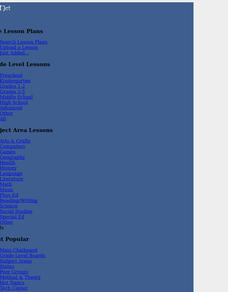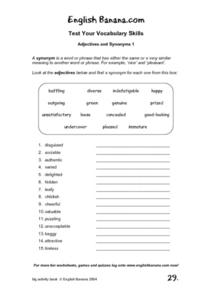Curated OER
Africa's Climatic Regions
Learners are introduced to the different climates and vegetation of Africa, and compare them to similar climatic regions found in the United States.
Curated OER
Handling Emergencies and Placing Emergency Calls
Learners create posters detailing how to activate 911. They design posters and research websites for local police department information and 911 calling advice. They write directions for placing emergency calls and crete their posters...
Curated OER
Figurative Language: Metaphors and Similes
Fifth graders are introduced to the figurative language using metaphors and similies. They identify the similarities and differences between the two and practice developing their own to use in their writing. They illustrate their...
Curated OER
Dichotomous Key for Identifying Pine Trees
Pupils identify the species of pine trees that are found in their area. They use unlabeled "mystery" samples and a dichotomous key to identify the pine trees to species. After identification, they use a field guide to answer worksheet...
Curated OER
Complete Metamorphosis
Students use a map and colored pins to plot the migration path of Monarch butterflies. They use data found at the Journey North website. Commas are also used in the activity to show how they are put in a series of words using butterfly...
Curated OER
Confronting Genocide
Students discover what the term genocide means and are assigned to groups to reasearch an act of genocide in order to answer each question from their worksheet. They then compare their results making special notes of patterns they observe.
Curated OER
Circle of Friends
Students investigate the meaning of friendship and how to make friends. In this friendship lesson, students make Venn Diagrams showing the similarities and differences of characters in two stories. They discuss their own circle of friends.
Curated OER
Martine Luther King Jr. and John Lewis: Speeches at the March on Washington, August 1963
Ninth graders study the Civil Rights Movement. In this American History lesson, 9th graders analyze the speeches of major civil rights leaders. Students compare and contrast the meanings of these speeches.
Curated OER
"Live Out Loud" Celebrates Pride Week
Students investigate human relationships by creating oil paintings in class. In this gay pride lesson, students discuss why the Pride parade is so important, who appears at the parade and how art is used to spread awareness of gay...
Curated OER
Classify Machines that Fly!
Eighth graders explore flight and the dichotomous key. In this flight lesson, 8th graders gain understanding of the dichotomous key and create one of their own. Students then use their dichotomous key to classify types of aircraft.
Curated OER
Developing Students' Vocabulary Range for Describing People
Middle schoolers develop vocabulary for describing people.
Curated OER
Boy Cricket Girl Cricket
Students investigate crickets. In this series of cricket activities, students observe and chart crickets. Students discuss the differences between male and female crickets, record findings in a journal, handle crickets, and read a...
Curated OER
Homophones dictation
Learners notice their problems with a particular listening activity or even with spelling a word wrongly. They write 8 to 10 homophones and check what they have written down. They say the spelling and also the meaning and discover the...
Curated OER
Wolf Habitat
Students identify their own basic needs for food, water, shelter and space in a suitable arrangement. They generalize that wolves and people have similar basic needs.
Curated OER
Communities
Students examine the similarities and differences between rural, suburban, and urban communities. They read about type of community in their social studies textbook, analyze the differences between Tokyo and Chicago, and complete a chart...
Curated OER
Fundamentalism
Eighth graders explore the historical roots of fundamentalism and determine whether fundamentalism is a religion or a political ideology. They will examine different religious fundamentalist movements around the world noting any...
Curated OER
Animal Alphabetizing
Second graders observe a stack of folders, papers, notebooks or other materials that need to be organized. They discuss what the word organize means and then practice alphabetizing books according to first names of students as a class....
Curated OER
Sing, America, Sing!
Students articulate their thoughts about citizenship in songs and poems. They write a songor a poem that describes what citizenship means to them. They plan a Citizenship Day during which students perform their songs and read their poems.
Curated OER
Geography & Places in SE Utah
Students evaluate SE Utah and Four-Corners place names in relation to geographical characteristics of place. They examine a map of Four-Corners region and take notes listing places they know. They list the meaning of the place name and...
Curated OER
The Spanish Belief in Justice and Values
Fifth graders study "justice" and "values" as illustrated through fables. The determine that some of the fables in the U.S. are relatively similar to those fables in other parts of the world. They write and illustrate their own fables.
Curated OER
Same, But Different
Young scholars compare and contrast specific characters in the book, "Old Henry." They discuss similarities and differences between people and define character traits. They assess one's own character traits and have a class discussion...
Curated OER
Using Authentic Texts to Teach Vocabulary
Students read an article identifying any new vocabulary words they are unfamiliar with. Using the text, they discover antonyms, synonyms and word families. They answer comprehension questions and review the vocabulary to end the lesson.
Curated OER
Adjectives and Synonyms 1- Test Your Vocabulary Skills
In this vocabulary skills worksheet, students read the definitions of the word "synonym" at the top of the page before looking at a list of 15 words. They choose an adjective from the word bank that is a synonym for each word and write...
Curated OER
Grain Properties Activity
Students study the similarities and differences of five different grains. They analyze the characteristics of corn, sunflower, milo, wheat, and soybeans.

























